| 914-967 (161- 213 AD) (L'Uniona Homanus) | 967-1000 (213-247 AD) (L'Uniona Homanus) |
Point of Divergence[]
The Year is 914 AUC (161 AD) and Marcus Aurelius is the Emperor of Rome. The campaign on the Rhinus (Rhine) River are an extreme success and there are parades in his honor. The Norther Frontier is now at the Albis (Elbe) and there are many more areas poised to challenge Roman power. The Roman Empire named three quarters of the new territory Germania with the last Quarter, from the end of the Ister (Danube) to halfway down the Albis, named Aurelia in honor of Marcus Aurelius.
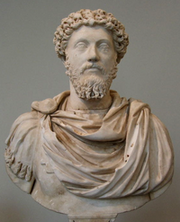
Marcus Aurelius, Roman Emperor 914-933 AUC (161-180 AD)
The Civilizing of the Provinces[]
Many of the lands of Germania that were brought under the veil of the Empire were mostly made of Forests and unexplored territory. This became a great asset to be sold by the Emperor and the Senate to people who were seeking the freedom of many open areas of frontiers which would also provide protection and capital to the bases, forts, and development to these areas. This was also started in the areas of Interior Hispania (Spain), Lusitania (Portugal), Lugdunensis (Northern France), and Britannia (England and Wales). The Rivers of these areas quickly became spotted with new cities and some already existing ones filled with new settlers. Many of these were recently freed slaves, poor farmers, and other lower class people from Rome, Greece, North Africa, Syria, Aquitania, and Judea, and the already populated areas of Italy. The wealthy of Rome used this opportunity to make great villas and estates in the open areas with the woods of the vast forests. The treasury of Rome surged.
One of these settlers was a young successful general from Alexandria who was for a long time a patron of Intellectuals and Libraries. His name was Carolus and the Nubian tribes to the southern border of Egypt were almost eradicated by the legions he controlled. Marcus Aurelius saw two possibilities with Carolus, either to ignore him and risk a usurpation or to recognize his greatness and join with him. Rather than plunge Rome into a Civil War, Carolus was made Caesar in 924 (171) and Marcus remained Augustus. Their parade in Rome celebrating this defeat, coincidentally a decade after the defeat of the Germans, was met by great rejoicing except for Marcus Aurelius’s son, Commodus. He was intended to become the co-ruler with his father but then Carolus emerged to prominence outside of Egypt. In an attempt to satiate his son Marcus Aurelius pressured the Senate into making him Consul which he accepted without either a parade or any sort of event in the year 928(175), the people of Rome would have not noticed this development.
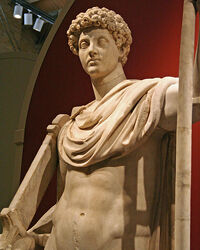
A statue of the Emperor Carolus
Carolus as Caesar spent much time in the Western Provinces than the Eastern Ones, which we dominated by the Augustus. The people of this region enjoyed the spread of knowledge that Carolus brought to the provinces from Alexandria through the freeing of slaves and employing them as copyists of the texts of the Great Libraries. These would be disseminated throughout the empire and other cities like Athens which had vast stores of knowledge would be included in this event. Marcus Aurelius upon doing this began to grow out a beard in the fashion of the old philosophers of Greece in honor of this program.
The Hammer of Rome[]
In 929 (176 AD) the armies of Parthia on the Asian Border with Rome teamed with the long neutral country of Armenia in an Attach on Syria. Marcus Aurelius arrived shortly with reinforcements from Greece quickly and sent word to Carolus in Gaul to bring more troops to the frontier. Marcus held off the Parthians fairly quickly and was intending to call off the reinforcements from Carolus and simply reinforce the borders of the empire but as soon as the attack concluded the real troops peeked over the horizon . The band that had been sent ahead was intended to be trumped up as a great threat but to cause little damage and serve more as a distraction so that when the real army came, the Romans would have half left. Just before the Great Parthian and Armenian hordes can over the horizon, from the sea Carolus and his troops came in with weapons and legions. The men poured in and there was so much blood, one poet later recounts, that the soldiers were slipping over it, the horror was such that the Armenian soldiers after seeing the destructive tactics Carolus and Aurelius had introduced the thought occurred to them to abandon the Parthians and they did so.
The devastating defeat of the Parthians in the Spring of 929, which was a conclusion of a long conflict once consisting of no more than occasional border raids, was shortly followed by a march on the Armenian capital of Artashat. The King of Armenia upon meeting the Emperor prostrated before him and pledged his allegiance to Rome and that his Army would move on the Parthian capital of Ctesiphon. Upon bringing this news back to Carolus he replied in adamant refusal to their proposition and contended that the Armenians, being cowards to their former ally, would abandon Rome as easily as a child abandons a broken toy. The Armenians were told that Rome would accept the conditions of peace if they would keep their army with the Roman Legions for a speech from their Emperor, who the aristocracy would agree to accept. At this the Armenians were to find their deaths, around 85% of their military was slaughtered by the legions, the King and Aristocrats were among the first to die and were met with no objection from their people. The Armenian People, upon pledging that they would allow their country to be integrated into the Empire, were left for the most part unharmed and the intellectuals of Egypt and Greece came up through Asia minor to civilize the area that made Rome reach the Caspian Sea.
The rich and fertile Armenian lands supported troops that grew even more before they would march on Ctesiphon. Carolus described this as the ‘Hammer of Rome’. And in 930 (177 AD) this hammer fell on the capital of Ctesiphon to be met with poor resistance from the exhausted soldier that were left chiefly around the palace. Carolus and Marcus Aurelius traveled through the cities which had been abandoned by the people upon hearing it; the Emperor sat in his throne with his throat already slit when the army stormed the palace after less than three hours of fighting the guards. These victories were sure to be met with resistance from the satraps that had pledged their allegiance to their former ruler, but they had become mostly independent from years of neglect. The moves to take troops from the satraps to be thrown at Rome was deeply hated by the satraps but they feared doing anything short of murdering the Emperor which was impossible due to the distance he kept from all of his subjects and administrators. the Parthian Satraps were allowed to keep their position and be declared governors of their regions. This name change was met with indifference at first but the spread of trade to the much larger empire was eagerly appreciated by the Parthians and many cities were established along these routes. Carolianensis (Baghdad) was dedicated to Carolus and Aurelianople (Tehran) was dedicated to Marcus Aurelius. Ctesiphon was in many ways rebuilt on Roman Architecture. Unlike the lands in Western Europe had become colonized and the knowledge of the Mediterranean; Parthia began to assimilate into European culture. The publication of knowledge of astronomy, medicine, and science began around Carolianensis and New Ctesiphon leading to the first Public Education Institution in the Roman Empire, open to the children from age six to sixteen in the cities. Books soon began to be open to people of modest wealth and were coveted by people who could afford them because of the prestige it gave them, overall however they remained rather rare compared to the wealth of the majority of the population.
Only one third of the Hammer of Rome was kept among the Parthian Provinces and the remaining two began returning to the European Provinces, expecting a glorious reception and they marched across Asia Minor and Byzantium into Thracia and later split into the other provinces where they originated. Instead, the Consul Commodus took the few remaining legions in Rome across the Euxenos (Black Sea) to the area that had become increasingly populated by pirate bands and violent raiders of two predominant groups on the Sea and up the Ister, the Bulgars and the Kievan Rus. Commodus attacked these bands and then quickly retreated so that the armies returning with his father and Carolus would be attacked in the return of 933 (180 AD). The Rus came by sea and the Bulgars by land in a maneuver that would destroy the legions from two sides. The inferior weaponry and the poor tactics of these two cultures originated with the impression that the tiny brigand Commodus had brought was the height of Roman Power at the time. The impression of this weakness and the attack by the Empire prompted the attack as well as the anxious leaders who were eager to show their strength and take the treasures of the Empire.
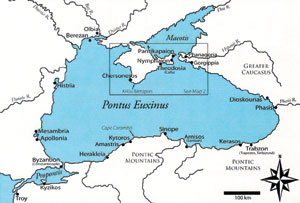
The Euxenos and Crimea (box)
The few living soldiers of these two powers traveled around the Black Sea, as their ships were too damaged to sail across the Euxenos, and were followed by the Hammer of Rome to be met at the Maeotian Sea (Sea of Azov). This resulted in the Crimean War. Kiev and the scattered towns of Sarmatia fell like dominoes but the true center of these barbarians was on the island of Crimea where the most intense fighting would be located. The Battle of Sipheropolis (Simferopol, Ukraine) would take so much force, because of the special terrain which the barbarians had fortified with high ground and low ground battlements that indicated planning and a Roman influence, though an indirect one. Marcus Aurelius led a steadfast attack onto the city and in the fray was one of the many Roman casualties. Carolus led the rest of legions to victory and the province of Crimea had all of its buildings burned in revenge by Carolus, as well as many of the people. The areas around the Euxenos and especially Crimea became fortified by the Romans and much of the culture of the barbarians was destroyed. Much of this land however was only populated by Military bases and their families with merchants coming in and out to supply them until the twenty-fifth anniversary of the death of Marcus Aurelius in 958 (205 AD).
Marcus Aurelius was honored around the eastern parts of the Empire. The Festival of Marcalia is celebrated on the Twenty Sixth of April and is a grand celebration from Rome to New Ctesiphon. Statues were built all across the Empire and funeral services started everywhere except one place, Rome. The day of Sol Invictus (the unconquerable sun), an idea supported by Marcus Aurelius to unite the Roman subjects religiously, was celebrated on the Twenty-Fifth of December (Christmas).
The March on Rome of 934 (181 AD)[]
Commodus never held any formal ceremony for the death of Marcus Aurelius. The Consul had convinced the other Senators that Marcus Aurelius and Carolus were seeking to destroy the Senate and take any power they continued to have. The Senators, being sheltered from the majority of the people of the empire and not heard of the recent conquests. Commodus told the Senate, rather than the truth as had been sent to him from his father, that the Mediterranean had been lost to Parthia and the legions that had left the European parts of the Empire had been almost entirely lost. The remaining army that will return to Rome was less than had left but more than half would return as the remaining settled in the lands of Parthia, Armenia, Crimea, Sarmatia, and Macromania around the Euxenos and Maeotian Seas.
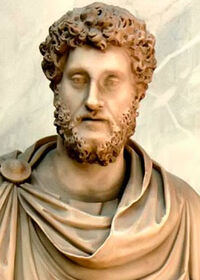
The Consul Carolus, son of Marcus Aurelius.
The March on Rome, which Carolus made his troops determined to after learning about Commodus’ deception, surprised the Roman populous as they believed the army had been destroyed and both emperors with them. The shock on the face of the Senators’ faces was even greater. Commodus was exposed as a liar, he had hoped both Carolus and his father would die in Crimea so he could become Emperor, the Senate denounced him and learned of the areas that had been added to the Empire and, without hesitation, declared Carolus to be the new Emperor, Carolus Parthius Armenius Antoninus, the Antoninus came as an honorific to his closeness to Marcus Aurelius, the last Antonine, as were Parthius and Armenius as a complement of his conquests. Commodus rather than be murdered outright was paraded through the Empire, and suffered intense embarrassment, harassment, and public humiliation, eventually to the end of Parthia where he was stabbed and body left to animals. His name became synonymous to a lying conspirator, fighting against more noble people behind their back.
Reforms in Agriculture and Education
Carolus consolidated the Empire from his ascension and no further conquest came to occur on the borders except when necessary to protect against border raids. Many new programs began around the Empire and one of these was one that had been attempted earlier in Rome when it was a Republic. Tiberius and Gaius Gracchus attempted an agricultural reform program that would redistribute the land of patricians, the wealthy, to the farmers and plebeian, the poor and middle class. This was instituted around the new provinces, as described above for the settlers, and in the long held lands of areas long held by permanently rich families. Lands with villas and buildings were allowed to extend outward to a certain degree proportional to the size of said villa or estate. This resulted, to the patricians surprise, a great benefit to the government of Rome. Grains, which used to be collected as taxes in many of the provinces for a long time for people without money, poured in vast quantities to the reserves all around the provinces. {C}This resulted in much less money to be held by the patrician class to sell the fruits of the labor of people that worked on their land as unfree dependents. This also resulted in a power shift from an elite, and very small group of families on almost all markets in the Empire, to a much wider group of people. Some decided to remain on lands that had been held by their lords by selling their land back to the lords and taking certain conditions for their service, an ability also guaranteed by the Lex Gracchi, but many more took this freedom and went with it and became a new merchant class in Rome. This happened from Parthia to Britannia almost without incident but in Italia and Greecia, where long established families started rebellions which was quickly put down by the Emperor. Many farmers began to opt into paying their taxes in money, that they earned from selling their grain, rather than in grain, which they would sell to make more money. The practice of subsidising grain, in Rome, stopped as the price of grain fell below the mark which made it unavailable to the poorest of Rome, recently becoming a middle class between slaves from frontiers and the dependents, at the bottom, and the super wealthy, at the top. The competition in the markets of the Empire, recently flooded with supply, brought lowered prices as the patricians could no longer manipulate prices to their wills.
As discussed above books were copied and sold much more widely and public education began and thrived, in Parthia, but their demand increased dramatically as the middle class could afford them and wanted the symbol, even if most could not read. Many copy areas could not produce them fast enough but were able to hire many more copyists with the increased monetary resources. Libraries began to spring up as far north as the mouth of the Rhine and expanded as far west as the former capital of Parthia, New Ctesiphon. The Power of the Emperor surged as the rivals of the patricians had been castrated by the loss of their resources and the fame of Carolus in the army protected him against usurpers among the troops. Fortifications along the borders effectively kept the many barbarians out of the Empire and were renovated often to assure this protection.
Trade flourished in the Empire from the chalk cliffs of Britannia, the timber fields of Germania, the wine and olives of the Mediterranean, the books, grain, fruits, clothing, glass and all other sorts of things as far as Sinica. One thing the Sinician had brought over the trade routes was the woodblock printing press. The crisis of production that the Roman copyists was well known to these merchants and they thought that this would be a great investment that would be highly coveted by the Romans back West. they brought this invention to the Empire first in Parthia, being the closest. The year 941 (188 AD) was when it arrived and immediately Parthia became a center of the literature trade. Upon hearing this development, which the Parthian printers tried to keep secret, the European and North African Copyists began to send spies to find the working of this invention. When they brought back the ideas to the areas of the Balkans and Syria, which had a long history of using and smelting iron, made the metal movable printed type printing press (prema ferrum) and this spread to the rest of the Empire.
As the price of grain fell with the increase in supply with the agrarian reforms, so did the price of books. Literacy became much more common not only among the wealthy but also to the middle class. One of the things that occurred with this was the start of a greater interest in Education.
Education as a practice for children began in Parthia and was slowly diffusing through the provinces of that region to other towns seeking to emulate the large cities of Carolianensis, New Ctesiphon, and Aurelianople. The Cities of Rome began to take this up since the establishment of the Republic, at least for the children of the wealthy, but had recently been expanded to include the children of the ever-growing middle class. The Schools of Greek cities like Athens expanded to include the lower classes and this occurred in every other city in the Empire. The smaller villages began to, if they could not fund their own schools, move to the cities to attend theirs. Some would leave the cities and establish new ones with the wealth of their own fortune and that of the people who followed them or came later. Overall the growth of cities across the Empire began at the time when any still working printing factory (primatorium) had a printing press. This machine itself began to be sold and individuals could begin to publicize their own products. The first newspaper began as a concept coming off of philosopher pamphleteers. The philosophies that emerged would shape the changes that would occur in politics and economics in the coming years.
Some local leaders began to be petitioned for the establishment of educational institutions, some would not do so unless the status that they and their families had was restored or even expanded. Carolus for the most part deposed of these corrupt men by force and established the educational institutions with the money they took from them and usually on whatever estates why lost. This set the example to start such establishment in other cities. Other times this happened by the force of the people of the city or area they rules as many newspapers called for people to no longer accept oppression.
The People of the Empire began to crystallize their identities in different ways. Many began to see themselves as citizens of their Province. Many remained under the impression that Rome was a republic and tried to influence the Senate and government of their province, Provincialists. Others sought to solidify their identity with the emperor and the empire, Imperialists. The Provincialists would create many programs and government programs in their province. The Imperialists would not stop trying to influence what they considered to be the only place from where real change could come in such a vast empire, the capital Rome. Immigrants seeking political power and reform began to flow to the banks of the Tiber.
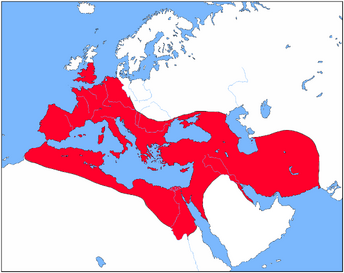
The Extent of the Roman Empire at the end of the Reign of Emperor Carolus.
The Constitution of 940 (187 AD)[]
The Emperors before Marcus Aurelius kept the aegis of the Senate intact and Carolus carried this on into his reign. The senators still held much power in the city of Rome where the Emperor could not escape them, as well as much fame among the people of the empire. No one wanted to disband the Senate and Carolus allowed it to continue but the seeds Commodus had planted in their minds, a fear of the centralization of power into an emperor, remained. They all knew, but would refuse to say in fear of being called friends of Commodus. The military felt so as well but Carolus feared neither as the wealth and fame he had brought to the Empire would protect him from any usurper. But the future of the Empire could be threatened by this thought.
The philosophies that began to gain support among the masses gained speed in the cities of the Empire. Constitutionalists decided that the government of their city should be placed in a single descriptive document that also guaranteed freedom to the people of the city, described the limits of their government, and record the laws enacted by an elected legislature (Comitia) and executed by another elected leader (a Dux in Latin).
The Constitution of Rome had long been a list of traditions and complex checks and balances but had recently fallen by the wayside with the unchecked power that quickly was consolidated in the Emperor. Carolus, thinking long term, wrote a constitution that would forever change the Roman World. The Constitutio Carolae (940, 187 AD) established several changes. It was written and revised by the Emperor and the Senators from the year 937 (184 AD). The constitution was split into different parts, Articuli, Article I concerned the people which were quickly formed the base of power. It described them as the source of all power and regular, open elections were the expression of that power. The Rights of the People began to be enumerated and would expand over the years. The first few concerned the right of every male to be a free citizen, to vote, to own property, to influence legislation, and to not be subjected to any authority violating these rights. The next part of this Constitution divided the provinces into Senatorial Provinces, those under the authority of Senators elected therefrom, and Imperial Provinces, those under the authority of the Emperor who was, ostensibly, appointed by the Senate but really intended to conform to the will of the Emperor as he stated prior to death.
Carolus was 44 years old when this Constitution was passed and it earned him a steady career from then onwards. The Years before his death in December, 966 (213 AD) at the age of Seventy-three went relatively unmarked as far as conquest. The border remained stable and the barbarians were allowed a controlled immigration ability, but were not allowed to stay together, Lex Immigratia, 942 (189 AD). The increase in wealth, education, and population rose all facets of Roman Life and a sense of community began to grew among the population.
“From Parthia to Aegyptus, Germania to Syria, Britannia to Sarmatia the Roman People have become a group that shall not be separated as easily as the empires of the time before. We have exceeded the wealth and prosperity of the past and all eyes are open or are beginning to open to the permanence of our Empire.” -from the ascension speech of the Emperor Ignacius to the Senate 967 (214 AD).
[]
| 914-967 (161- 213 AD) (L'Uniona Homanus) | 967-1000 (213-247 AD) (L'Uniona Homanus) |
